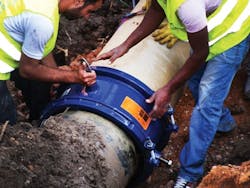About the author: Ed Nunes is product manager for Krausz USA, the creators of Hymax. Nunes can be reached at [email protected] or 855.457.2879.
Water and wastewater infrastructure is deteriorating due to lack of investment and funding. This means municipalities and utilities are looking to maintain their systems’ integrity at minimal cost. What can utility managers do to keep water and wastewater systems durable without replacing pipes, an expensive and time-consuming investment that also causes service disruptions?
Outlined are three repair strategies that managers can use to boost the durability of water and wastewater systems.
Restrain pipe where necessary
Restraining techniques ensure piping stays connected and help prevent costly repairs that can shut down a water or wastewater system. Connections such as 45s, 90s, end caps and hydrant connections are common points of restraint since they are where water flow is increased, making the connection a potential weak link. Restraints also are used in connections within wells, wastewater lift stations and treatment plants. When considering pipe restraint techniques, it’s important to examine factors that may affect the chances of pipe movement and separation. Criteria to consider include the nature of the piping system, ground movement and other ground stresses.
The nature of the piping system. The first consideration is the design of the piping system itself. In a pressurized buried pipeline, such as a water main or wastewater force main, axial thrust forces act on the pipe based on changes in fluid velocity, pipe size or pipeline direction. This generally happens at fittings, such as plugs, caps, valves, tees, bends or reducers. Such hot spots definitely need to be restrained.
Ground movement. Earthquakes and ground movement can cause connection failure, beam or shear breaks, and cracks along the length of a pipe. A region’s geographic phenomena can determine how much the ground moves. Some regions regularly experience ground movement, whereas others are relatively stable.
Ground movement also can be caused by seasonal weather changes, especially during winter and spring. The ground freezes in the winter, and ice melts in the ground in the spring—both cause major ground shifts. Ground movement also is correlated to extreme weather changes.
Other ground stresses. Pipe also can be affected by the ground in a variety of other ways. The amount of ledge or rock in the ground can negatively affect piping. If a high level of ledge is in the ground, even slight movements caused by traffic or weather can cause piping to break. Conversely, swampy areas with ground that is moist and spongy move easily and can stress pipes. There also is a long list of other environments that lead to pipes uncoupling, including tidal areas, bridge crossings and pipes running under water. In these circumstances, it is best to consult with engineers on how to evaluate the risks associated with a distribution system’s environment.
Several techniques are available to restrain pipe, including rodding, thrust blocks, and mechanical restraint devices and sleeves. Coupling restraint products are relatively new to the market and can be helpful. Such couplings use a mechanism to grip the pipes to restrain them. The products have been shown to be effective at a relatively low cost, as the restraining technology is within the coupling itself.
Offered in a range of diameters, coupling restraints can be useful in situations where utility lines either cross or run parallel to water and wastewater pipes. Such close pipe-to-pipe proximity makes it difficult—if not impossible—to install thrust blocks and rodding.
Allow for shock absorbers within the piping system
Shifting ground is one of the key reasons why pipes crack or break near where they are connected with couplings. This is especially common in the spring, when the ground thaws as cold winter temperatures give way to warmer weather. To minimize the effect of ground movement, use repair couplings that allow for angular deflection during installation (i.e., accept pipes that are positioned at a small angle), as well as continuous dynamic deflection, which helps absorb ground movement post-installation over time and minimize future pipe breaks.
In one coupling solution, a specially designed hydraulic gasket self-inflates using existing water pressure; as water pressure rises in the pipe, water enters the gasket and allows for dynamic deflection of the pipes while maintaining a perfect seal.
Make repairs the right way
It is common for installation crews to try to take shortcuts with pipe repairs, as they want to complete projects as quickly as possible, and municipalities try to maintain their water infrastructure with increasingly tight budgets. While there is temptation to take shortcuts, these “savings” cost time, money and worker safety.
Pipe repair shortcuts never last, and often increase costs. When repairs have to be redone, communities are left to deal with additional costs, service interruptions, and restricted traffic due to road closures and detours. Not only that, when a crew enters a repair site a second time, the ground is less stable, which can increase the chances of the ditch caving in.
Take the time to measure the pipe outside diameter to pick the correctly sized repair product and ensure a strong pipe connection that will last. For nighttime repairs, use proper lighting to illuminate work areas, not simply backhoe or excavator lights, which are not strong enough and can compromise safety. Finally, use quality parts. You cannot afford to purchase products that will fail early, requiring another repair, and no utility can afford the cost of making a second repair at the same location. Couplings and clamps that are easy to install also can make repair jobs more efficient, save time and help eliminate installation errors.
Maintaining the integrity of water and wastewater infrastructure is a challenge with municipal budgets being stretched in many cases. By using these strategies, utility managers can help ensure their piping infrastructure remains stable without the expensive step of replacing pipe.
